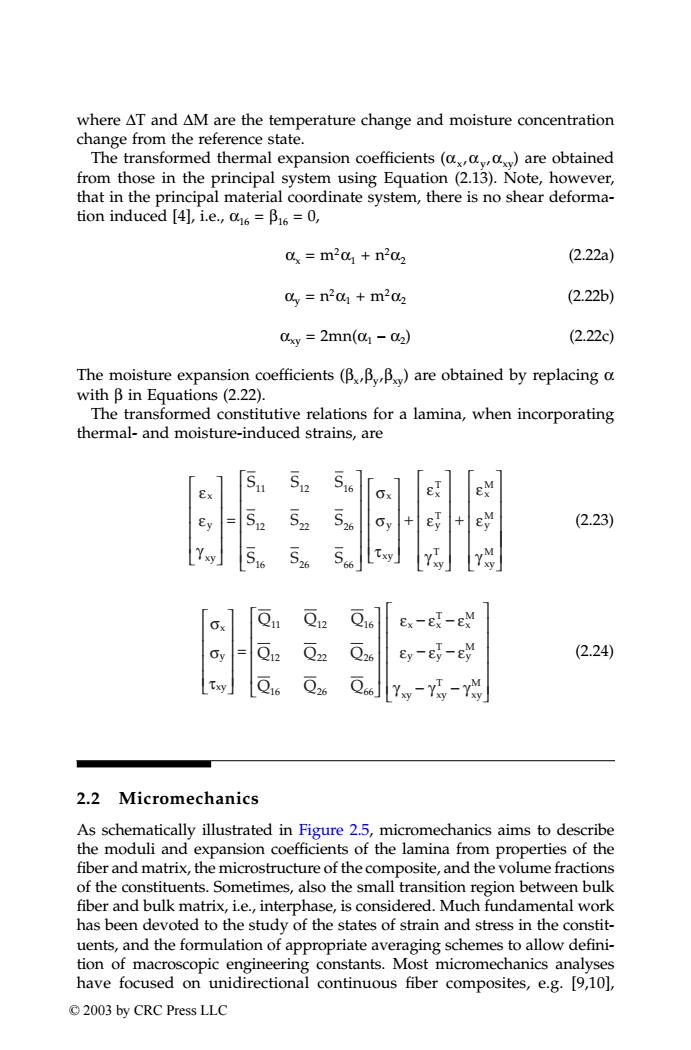正在加载图片...

where AT and AM are the temperature change and moisture concentration change from the reference state. The transformed thermal expansion coefficients (a)are obtained from those in the principal system using Equation(2.13).Note,however, that in the principal material coordinate system,there is no shear deforma- tion induced [4],i.e.,6=B16=0, 0=m201+n202 (2.22a) 0y=n21+m202 (2.22b) y=2mn(a1-02) (2.22c) The moisture expansion coefficients(B,B.,B)are obtained by replacing a with B in Equations(2.22). The transformed constitutive relations for a lamina,when incorporating thermal-and moisture-induced strains,are Ex Ey Oy (2.23) 516 56 Ox Q Q16 Ex-ET-EM Oy Qi2 Qz 36 ey-e时-e (2.24) Q Q36 Y-Ys-Yw 2.2 Micromechanics As schematically illustrated in Figure 2.5,micromechanics aims to describe the moduli and expansion coefficients of the lamina from properties of the fiber and matrix,the microstructure of the composite,and the volume fractions of the constituents.Sometimes,also the small transition region between bulk fiber and bulk matrix,i.e.,interphase,is considered.Much fundamental work has been devoted to the study of the states of strain and stress in the constit- uents,and the formulation of appropriate averaging schemes to allow defini- tion of macroscopic engineering constants.Most micromechanics analyses have focused on unidirectional continuous fiber composites,e.g.[9,10], ©2003 by CRC Press LLCwhere ∆T and ∆M are the temperature change and moisture concentration change from the reference state. The transformed thermal expansion coefficients (αx,αy,αxy) are obtained from those in the principal system using Equation (2.13). Note, however, that in the principal material coordinate system, there is no shear deformation induced [4], i.e., α16 = β16 = 0, αx = m2α1 + n2α2 (2.22a) αy = n2α1 + m2α2 (2.22b) αxy = 2mn(α1 – α2) (2.22c) The moisture expansion coefficients (βx,βy,βxy) are obtained by replacing α with β in Equations (2.22). The transformed constitutive relations for a lamina, when incorporating thermal- and moisture-induced strains, are (2.23) (2.24) 2.2 Micromechanics As schematically illustrated in Figure 2.5, micromechanics aims to describe the moduli and expansion coefficients of the lamina from properties of the fiber and matrix, the microstructure of the composite, and the volume fractions of the constituents. Sometimes, also the small transition region between bulk fiber and bulk matrix, i.e., interphase, is considered. Much fundamental work has been devoted to the study of the states of strain and stress in the constituents, and the formulation of appropriate averaging schemes to allow definition of macroscopic engineering constants. Most micromechanics analyses have focused on unidirectional continuous fiber composites, e.g. [9,10], x y xy x y xy x T y T xy T x M y M xy M = SSS SSS SSS ε ε γ σ σ τ ε ε γ ε ε γ + + 11 12 16 12 22 26 16 26 66 x y xy 11 12 16 12 22 26 16 26 66 x xT x M y yT y M xy xy T xy M = QQQ QQQ QQQ σ σ τ εεε εεε γγγ − − − − − − TX001_ch02_Frame Page 17 Saturday, September 21, 2002 4:48 AM © 2003 by CRC Press LLC